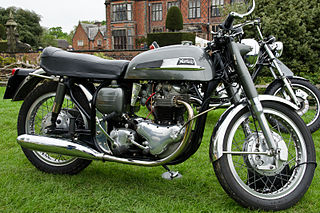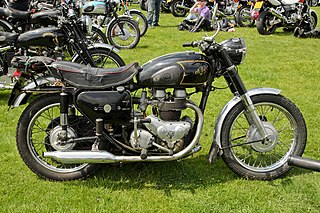
The Norton Motorcycle Company is a brand of motorcycles headquartered in Solihull, West Midlands,, England. For some years around 1990, the rights to use the name on motorcycles was owned by North American financiers.

A. J. Stevens & Co. Ltd was a British automobile and motorcycle manufacturer in operation from 1909 to 1931. The company was founded by Joe Stevens in Wolverhampton, England. After the firm was sold, the name continued to be used by Matchless, Associated Motorcycles and Norton-Villiers on four-stroke motorcycles until 1969, and since the name's resale in 1974, on lightweight, two-stroke scramblers and today on small-capacity roadsters and cruisers. The company held 117 motorcycle world records.

Matchless is one of the oldest marques of British motorcycles, manufactured in Plumstead, London, between 1899 and 1966. A wide range of models were produced under the Matchless name, ranging from small two-strokes to 750 cc four-stroke twins. Matchless had a long history of racing success; a Matchless ridden by Charlie Collier won the first single-cylinder race in the first Isle of Man TT in 1907.

Associated Motor Cycles (AMC) was a British motorcycle manufacturer founded by the Collier brothers as a parent company for the Matchless and AJS motorcycle companies. It later absorbed Francis-Barnett, James, and Norton before incorporation into Norton-Villiers. Henry Herbert Collier founded Matchless as a cycle company in 1878. His sons Henry (Harry) and Charles (Charlie) joined him and the name was changed to H. Collier & Sons.
Norton-Villiers was a British motorcycle manufacturer formed in the 1960s following the collapse of AMC. With the general decline of the British motorcycle industry, under a British Government initiative it was later combined with the remnants of BSA Triumph to form Norton-Villiers-Triumph.

The Norton Commando is a British Norton-Villiers motorcycle with an OHV pre-unit parallel-twin engine, produced by the Norton Motorcycle company from 1967 until 1977. Initially having a nominal 750 cc displacement, actually 745 cc (45.5 cu in), in 1973 it became an 850 cc, actually 828 cc (50.5 cu in). It had a hemi-type head, similar to all OHV Norton engines since the early 1920s.

The Matchless G80 is a single cylinder 500 cc British motorcycle built by Associated Motorcycles (AMC) between 1946 and 1966. During the 1950s and 1960s, the main export product for AMC was the AJS/Matchless range – the road bikes were very similar, often with only the badges distinguishing one marque from the other; the equivalent AJS being the Model 18.

Peter Williams was a British former professional motorcycle racer. He competed in Grand Prix motorcycle road racing from 1966 to 1973. He also competed at many levels on home short-circuit races. He raced many times on the Isle of Man TT course from 1966 to 1973. His father was Jack Williams who ran the Associated Motor Cycles (AMC) race department. Williams trained in mechanical engineering and introduced via racing alloy wheels, an innovation which is commonplace on today's road bikes, and was also an early pioneer of solo-motorcycle disc brakes.

The AJS 500cc Model 18 and AJS Model 18S are 500 cc British motorcycles almost identical to the Matchless G80 and both were produced in the same Associated Motor Cycles (AMC) London factory from 1945 to 1966. These bikes represent the end of the era of big British singles, as when AMC merged with Norton production concentrated on twins.

The Matchless G50 is an historic racing British motorcycle made by Associated Motorcycles (AMC) at the former Matchless works in Plumstead, London. Developed in 1958 from the 350 cc AJS 7R, but with the engine capacity increased to 500 cc, 180 G50s were built in the next four years. Although less powerful than its main competitor the Norton Manx the G50 proved highly competitive at three hundred pounds and was faster round bends. If success is measured by longevity then this is the most successful Matchless motorcycle, and high specification replicas are still being produced to this day, although financial problems at AMC ended production in 1963.

The Dominator is a twin cylinder motorcycle developed by Norton to compete against the Triumph Speed Twin. The original Dominator was designed in 1947 and 1948 by Bert Hopwood, who had been on the Speed Twin design team at Triumph. Available for sale from mid 1949, this design set the pattern for Norton twins for the next 30 years.

The AJS Model 31 was a British motorcycle made by Associated Motor Cycles at the former Matchless works in Plumstead, London. Developed in 1958 specifically to capture the potentially lucrative US market, the last Model 31 was produced in 1966.

The Norton Atlas was a Norton motorcycle made between 1962 and 1968, until it was replaced by the Norton Commando.

The AJS Model 16 was a British motorcycle made by Associated Motorcycles at the former Matchless works in Plumstead, London.

The Norton P11 is a 745 cc (45.5 cu in) air-cooled OHV parallel twin motorcycle that was made by Norton-Villiers from 1967 to 1969. Designed as an extremely light high power-to-weight ratio desert racer, P11 was revised in 1968 to the P11A and marketed as the Norton Ranger, a road legal version of the P11 with a more comfortable seat to make it suitable for normal road use. The Norton P11 gained a reputation as a 'desert racer' in the late 1960s but by 1969 lighter two stroke desert racers began to dominate the sport and the Norton had begun Commando production and it was selling well. Norton ended production of the P11 series to concentrate on the Commando, which used a number of ideas developed on the P11 series.

Berliner Motor Corporation was the US distributor from the 1950s through the 1980s for several European motorcycle marques, including Ducati, J-Be, Matchless, Moto Guzzi, Norton, Sachs and Zündapp, as well as selling Metzeler tires. Berliner Motor was highly influential as the voice of the huge American market to the motorcycle companies they bought bikes from, and their suggestions, and sometimes forceful demands, guided many decisions in Europe as to which bikes to develop, produce, or discontinue.
Joe Berliner [...] a man endowed with great decision-making power in Borgo Panigale

Colin Jordan Seeley was a British motorcycle retailer who later became a motorcycle sidecar racer, motorcycle designer, constructor and retailer of accessories. In 1992 he was involved in running the Norton Rotary race team.

The Norton Commando Production Racer was a hand built production racer produced by Norton-Villiers from 1970 - 1972. It was based on the road-going Norton Commando, and although fitted with lights it was never intended as a road bike. The model was commonly known as the Yellow Peril.

The Norton Model 88 Dominator, also originally known as the Dominator De Luxe was a 500 cc vertical twin motorcycle manufactured by the British Norton Motorcycle Company from 1952 to 1966. It was the first of Norton's motorcycles to use the featherbed frame, which established Norton's reputation of producing fine handling machines. The 88 used the Bert Hopwood designed engine that was first fitted to the Model 7 and was initially for export only. It became available on the home market in 1953. Norton were a small manufacturer at the time and without the economies of scale the model was expensive compared to other manufacturer's equivalent machines. The 88 retailed for 20% more than the contemporary Triumph Speed Twin and was dearer than the 650 cc Triumph Thunderbird.

The Norton Model 99 Dominator was a 600 cc vertical twin motorcycle manufactured by the British Norton Motorcycle Company at their Bracebridge St, Birmingham factory from 1956 to 1962. The 99 was based on the 500 cc Model 88 Dominator with an enlarged engine. The model was superseded by the 650SS.



















